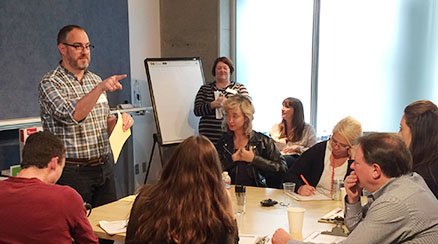No More ‘Thud!’ 4 Tips to Turn Your Insights into Action
THUD!
That was always the noise I imagined a research report made when it landed on a client’s desk. Pages and pages held together with a big binder clip, packed full of data yet the “so what” and “now what” were absent, requiring the client to sift through it, make meaning and socialize it within the organization.
Collectively, the insights field has moved forward so those implications and recommendations are usually featured. The ‘thud’ I hear today is one of inertia. No matter how great the storytelling to inspire the team, no matter how spot on the recommendation, if you can’t get beyond the hurdle to achieve some action, the results of your work (and your client’s money) might as well be sitting in a stack on the client’s desk, collecting dust like those reports of yore.
What’s behind the inertia? Look no further than your calendar for a clue. Too many meetings, too many projects, not enough time to think, let alone do, leaves many clients fighting the “fires” instead of tending to the business of the business.
It’s like we’ve afflicted ourselves with a version of attention-deficit disorder. As soon as the presentation ends, everyone focuses their attention on the next shiny object – the next meeting that starts seconds after this one ends. There are more shiny objects in the hours that follow, not even counting the emails and texts that are piling up. That leaves the insights, the crafted story, the recommendations sitting on the conference table. Hopefully the delivery wasn’t a ‘thud’ but the inertia makes it drop like a stone.
In the meantime, insights organizations are encouraged to act more like a consultancy and strategic partner to their internal clients. It makes sense and I agree, but the reality of time constraints and workload creates the inertia that makes that shift in behavior a real challenge. If the common complaint about insights is that it’s just sharing data, then the logical step is to go from sharing data to creating action.
What can we do as an industry to avoid inertia and create action? We can add a step to begin to apply insights into work streams. Help the team transition from the presentation into a true “what do we do now” conversation. A practical way to do that is to reimagine the final report share out. Evolve it into something more dynamic like an Application Workshop (or Activation Workshop depending on your company’s nomenclature).
You have to go beyond reporting, past presenting, and into facilitating conversation with the client team.
Facilitation can be done by either the internal client researcher or the research partner. The dynamics and politics in your organization and team will help make the determination of who’s best suited for the role.
Where do you start? How do you structure these conversations?
Here are 4 tips I can share from Application Workshops that I’ve facilitated recently:
1. Know Where You are Going
Give your workshop structure. Have an agenda for the conversation. For example, push your key takeaways or recommendations forward for discussion on what to do with them. Keep time reserved for new ideas that come up based on the learning you’ve shared.
2. Present Questions for People to Answer
As the share out gets underway, we start by asking the team to think about how this learning will be applied in their day-to-day role. It gets them thinking about how they might see their consumer or business problem differently and what they might do to change their own behavior. Make space in the workshop portion to have people share their answers to this question.
3. Create a Safe Space for People to Bring Their Thinking Out Into the Open
Nothing kills creativity like the fear of being judged for their ideas. To help people share their ideas and form their thinking, lay out the ground rules for the session, including that this is a space for people to share their thinking, not just finished thoughts. This gives people permission to share an idea that perhaps others will be able to help build into the next “killer app.”
4. Assign Ownership of Next Steps
An idea is like a spark. It needs oxygen and material to burn in order to become a flame. Make sure the ideas that come out are prioritized and assigned to individuals for follow-up. Giving responsibility creates accountability, which is what’s needed to spark action.
Clients and research partners working together have the ability to turn the corner and evolve the share-out into an application session that not only informs and inspires but generates action. To get the result will require a change in thinking, behavior and structure around the traditional share-out but the outcome will be a move from information-sharing into action-planning. That, in turn, will increase the value of the contribution of the insights organization as it moves from data center to valued partner and strategic consultant. No more ‘thud’!
For more tips on creating presentations and storytelling, check out the following…
Our recent webinar on framing the big idea and how to tell stories in the room.
3 Presentation Tips that will have your audience eating out of your hand.


